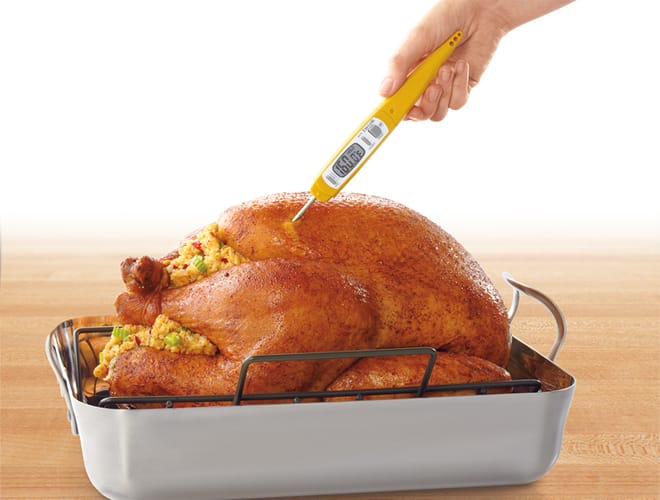A meat thermometer ensures that you cook meat sufficiently and evenly. Knowing what to look for in this vital culinary tool helps you choose the right model for your kitchen.
Check out the following must-know facts before buying a meat thermometer:
1. Types of meat thermometers
Several types of meat thermometers exist, all featuring a different type of design and varying usage requirements.
*Oven-proof, dial meat thermometers have a thick post that you insert into the meat, and you leave these models in during cooking. The dial on these thermometers accurately displays the internal temperature of the meat, as long as the cut is at least 2 inches thick.
*Digital or dial instant-read meat thermometers are not designed to place in the oven, but are instead inserted into the meat at the end of the cooking time when you want to measure internal temperature for doneness. These display a digital or dial reading after just a few seconds.
*Microwave-safe thermometers are designed specifically for microwave ovens.
*Probe thermometers are two-piece systems. The probe remains in the food while it’s cooking, but the base of the thermometer stays outside of the oven, and the display shows you the internal temperature of the food as it cooks. Many models feature pre-settable alarms that allow you to choose the type of meat you’re cooking and how well you want it done. There are even portable probe thermometer systems that you can carry around with you that announce when your food is cooked to specifications.
*Temperature forks aren’t designed to stay in food during cooking, but are instead used to test for doneness. Such thermometers read in just seconds and are ideal for testing grilled foods.
2. Accuracy
Most meat thermometers are fairly accurate and aren’t generally off by more than 1-2 degrees. Some meat thermometers have a test mark that you can use to measure for accuracy. You place the thermometer into boiling water up to the test mark and verify that it reads 212 F. Instant-read types of thermometers often have a re-calibration feature that can be used when necessary to adjust the thermometer for accuracy.
3. Ease of Use
Some meat thermometers are easier to read than others, depending on the style of the dial. You may or may not be able to read an oven-proof thermometer through the oven door, so this is a consideration. Probe thermometers are especially easy to use because you simply insert the thermometer in the meat and then read the display that sits outside of the oven.
Digital/dial instant-read thermometers and temperature forks are a little more cumbersome because you must remove the meat from the oven in order to test for doneness.
Meat thermometers that stay in during cooking are hot to the touch and must be removed with caution.
4. Durability
Many meat thermometers are made with durable stainless steel and some are dishwasher safe. The glass on most thermometers is shatterproof.
Now that you know all about meat thermometers, you can choose the best model for your upcoming cooking needs.
Tell us which do you prefer — a digital or dial instant-read thermometer?
Julie Bawden-Davis

